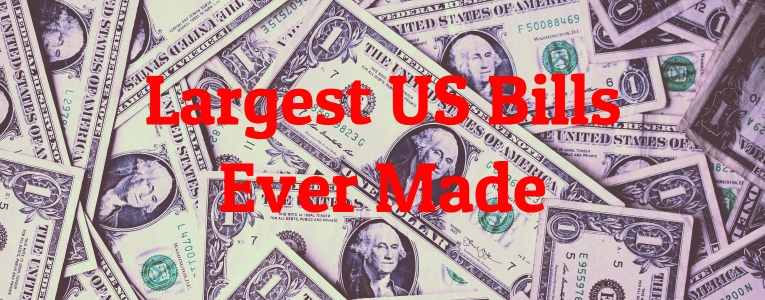Large U.S. bill legislation has long been debated. These $500-plus notes have been circulating for decades but are seldom used. Due to counterfeiting and commercial rejection, this is the case.
Big banknotes are vulnerable to counterfeiting. Counterfeiters target these high-value notes to earn a fast profit. The government has added unique paper, watermarks, and other characteristics to make these banknotes harder to counterfeit.
Large banknotes are nonetheless useful despite these issues. Banks and other financial organizations utilize them for significant transactions like stock and real estate sales. Those who wish to buy a lot without carrying a lot of cash use them too.
In the digital era, huge bills are unusual. Many individuals no longer carry cash due to credit and debit cards and other digital payment options. Large banknotes have become more noticeable and less helpful in daily transactions.
Large US banknotes have a rich history but are becoming uncommon. They still have some valid applications, but worries about counterfeiting and that many establishments do not accept them have made them less useful for routine transactions. As the digital era progresses, their usage may dwindle.
-
$500 John Quincy Adams Bill
Type of Denomination: Legal Tender
Year Created: 1869
Remarks: Justice portrait by Stephen Schoff on reverse
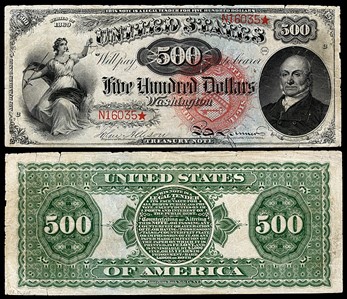 Source: Wikimedia
Source: Wikimedia
The $500 John Quincy Adams Bill is noteworthy American money. This banknote depicts John Quincy Adams, the sixth US president from 1825 until 1829.
The Series of 1869 included redesigned and more secure money, including the $500 John Quincy Adams note. The highest denomination in this series was $500.
The bill’s front has an image of Adams, “The United States of America,” and “Five Hundred Dollars” in huge lettering. The bill’s reverse shows the Justice portrait by Stephen Schoff.
The rare and precious John Quincy Adams Bill is a historical piece of American cash. Collectors prize it for its rarity and historical importance, and its value is projected to rise. It is a treasure and an interesting piece of American financial history.
Did You Know?
Despite its large value, the $500 John Quincy Adams Bill was seldom used outside of bank transactions. A few of these banknotes were produced, and collectors value them highly. These $500 John Quincy Adams Bills retail for hundreds of thousands.
-
$1,000 Alexander Hamilton Bill
Type of Denomination: Federal Reserve Note
Year Created: 1918
Remarks: Eagle on reverse
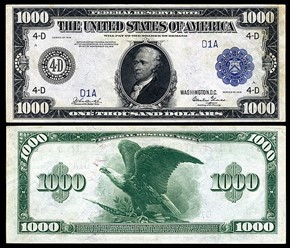 Source: Wikimedia
Source: Wikimedia
The 1912 series $1,000 Alexander Hamilton Bill is rare and valuable. The 1912 US Treasury note depicts founding father Alexander Hamilton.
The $1,000 banknote was originally used for significant bank transactions. Just a few were made since it was not meant for public consumption. Approximately a few thousand of these banknotes were produced.
The 1912 $1,000 banknote is rare and high-value. Today’s $1,000 note is worth $27,000. Collectors value the bill well beyond its face value due to its historical importance and rarity.
In 1969, the US government abolished the $1,000 bill to prevent money laundering and other crimes. This decision removed all $500, $1,000, $5,000, and $10,000 banknotes from circulation, making the 1912 $1,000 dollar rarer and more valuable.
The 1912 $1,000 Alexander Hamilton Bill is interesting American money with historical and monetary value. Collectors prize it for its rarity, high face value, and US Treasury workmanship.
Did You Know?
The 1912 $1,000 dollar is among the most valued American bills. A 1912 $1,000 note sold for $2.6 million at auction in 2013.
-
$5,000 James Madison Bill
Type of Denomination: Federal Reserve Note
Year Created: 1918
Remarks: Washington resigning commission on the reverse
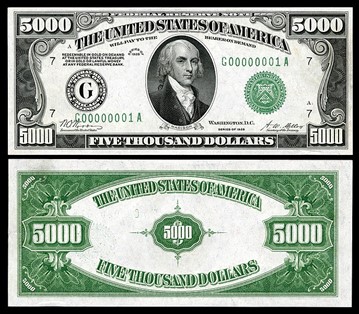 Source: Wikimedia
Source: Wikimedia
Very few examples of the $5,000 James Madison Bill from 1918 make it one of the rarest and most precious pieces of U.S. money. The James Madison Bill is well-known among numismatists but not outside their subculture.
The bill was produced by the Bureau of Engraving and Printing and sent to banks in limited quantities; it contains an image of James Madison, the fourth President of the United States.
Intricate engraving and design features were used on the James Madison Bill and other high-denomination banknotes to prevent forgery.
The words “The United States of America – Five Thousand Dollars” appear above and below James Madison’s face on the front of the bill.
Did You Know?
It was never meant to be used by the general people but circulated only between financial institutions. That’s why there aren’t many surviving examples of this legislation.
-
$10,000 Salmon P. Chase Bill
Type of Denomination: Federal Reserve Note
Year Created: 1918
Remarks: Embarkation of Pilgrims on the reverse
 Source: Wikimedia
Source: Wikimedia
History aficionados and monetary system enthusiasts want the 1918 $10,000 Salmon P. Chase Bill. Salmon P. Chase, an American politician and lawyer was Lincoln’s Secretary of the Treasury during the Civil War. Chase funded the war and stabilized the economy.
In 1918, Chase’s picture appeared on a $10,000 note. The Chase bill was designed for major financial transactions between banks and the federal government. The banknote was not designed for broad circulation due to its high value.
Collectors value the bill’s rarity and historical importance. The Chase bill is among the most valuable pieces of American currency, ranging from tens to hundreds of thousands of dollars depending on condition and rarity.
Numismatists love the 1918 $10,000 Salmon P. Chase Bill. Its rarity, historical importance, and high worth make it a prized piece of Americana that will undoubtedly inspire future generations.
Did You Know?
Its brief lifespan makes the Chase bill rare. In 1934, the government stopped making banknotes exceeding $100, including the Chase bill. The authorities burned most banknotes, but others remained in circulation.
-
$10,000 Andrew Jackson Bill
Type of Denomination: Legal Tender/Gold Certificate
Year Created: 1878
Remarks: All notes redeemed
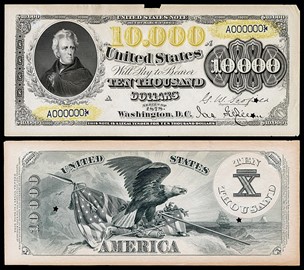 Source: Wikimedia
Source: Wikimedia
The history of American money is intriguing, from the early colonial era when each province issued its own currency until the founding of the United States Mint in 1792. The 1878 $10,000 Andrew Jackson banknote is fascinating.
The U.S. government produced the $10,000 banknote for interbank transactions. The bill’s front depicted former President Andrew Jackson, who served from 1829 to 1837.
The Currency Act of 1862 permitted paper money during the Civil War, which approved the bill. By 1863, the government produced $1,000 and $5,000 banknotes, up from $500. The $10,000 gold certificate was launched in 1878.
Gold certificates may be converted into coins anytime, simplifying huge transactions without requiring gold coinage. The $10,000 banknote was intended for bank-to-bank transactions only.
Did You Know?
The $10,000 note is contentious despite its rarity and historical importance. It’s seen as a symbol of American exceptionalism and economic strength by some and the concentration of wealth and power by others.
-
$100,000 Woodrow Wilson Bill
Type of Denomination: Gold certificate
Year Created: 1934
Remarks: Never in circulation
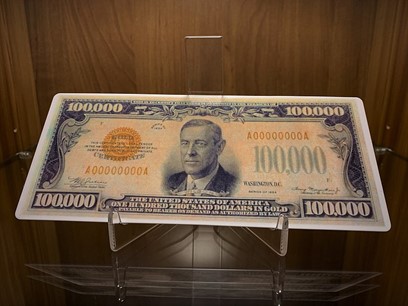 Source: Wikimedia
Source: Wikimedia
The $100,000 Woodrow Wilson Bill is the largest US bill ever made. In 1934, the US government released the $100,000 bill. It depicted Woodrow Wilson, the 28th US president from 1913 until 1921. The highest-denomination US currency was not available for public usage.
From 1918 until 1934, the Federal Reserve Bank produced high-denomination banknotes, including the $100,000. Federal Reserve Banks utilized these notes for Treasury transactions. They also transacted with foreign central banks. They were seldom used because of their high denomination.
Woodrow Wilson’s $100,000 bill is rare. It was never meant for public use but was crucial to the Federal Reserve Bank and US Treasury’s financial activities. It reminds us of a period when money and the economy differed in the US.
Did You Know?
The $100,000 bill is now a collector’s item. Just a few hundred of these banknotes were produced, and most were destroyed once they were pulled out of circulation. Several of them are in private collections and museums worldwide.
<h3> RELATED READING </h3>
10 Largest Investment Banks in the World
10 Largest Banks in the World
7 Largest Credit Card Processors In The World
10 Largest Mutual Fund Companies in the World
10 Largest Hedge Funds in the World
